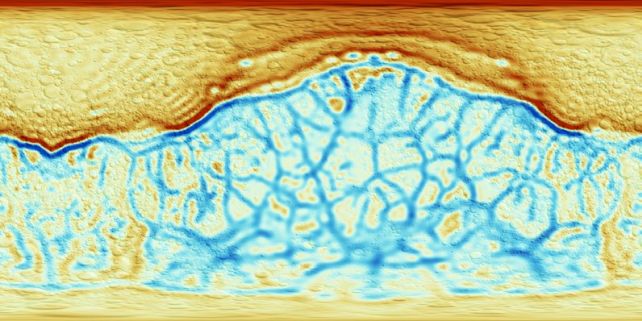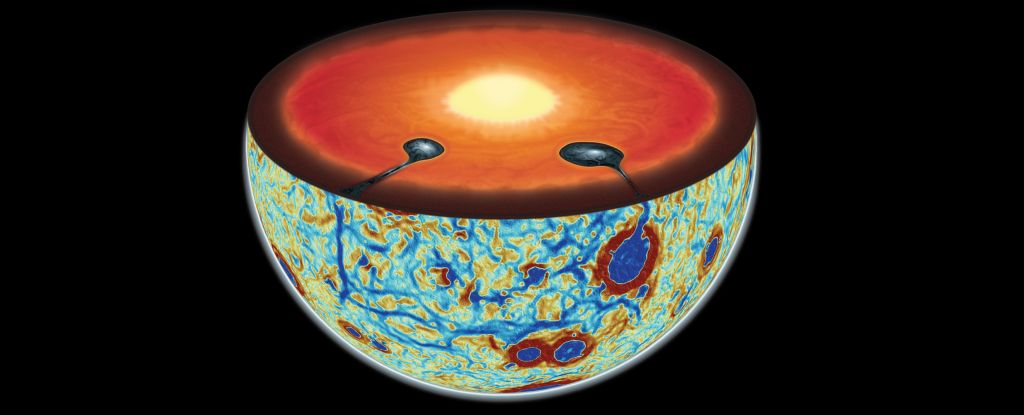The Moon is a great whackin’ oddball in the sky, and scientists may have just figured out part of the reason why.
Its surface is chemically asymmetrical, and new evidence suggests that’s because the Moon’s mantle flipped topsy-turvy upside-down when the Moon was only young. What was on top of Earth’s satellite went underneath; what was below came out into the light.
Lunar scientists have been thinking about lunar mantle overturn for decades. Now we have new evidence to support it. Led by planetary scientists Weigang Liang and Adrien Broquet of the University of Arizona, a team of researchers has found that the gravity map of the Moon best fits this model of mantle overturn.
In a series of simulations, the team showed how gravitational anomalies on the near side of the Moon are consistent with the presence and location of dense rocks bearing dense minerals that have been preserved since the Moon’s early days.
“This interpretation is supported by the compelling similarity between the observed pattern, magnitude and dimensions of the gravity anomalies and those predicted by geodynamic models of the ilmenite-bearing cumulate remnants,” the researchers write in their paper.
Moreover, the researchers precisely dated when this overturn happened: some 4.22 billion years ago, shortly after the Moon formed from a chunk of Earth that broke off during a violent collision early in the history of the Solar System.
frameborder=”0″ allow=”accelerometer; autoplay; clipboard-write; encrypted-media; gyroscope; picture-in-picture; web-share” referrerpolicy=”strict-origin-when-cross-origin” allowfullscreen>
One of the most peculiar things about the Moon has to do with its surface. On the near side of the Moon, there’s a region best described as “geochemically weird“. Known as the KREEP Terrane, it’s rich in specific and unexpected metals: potassium, rare earth elements, and phosphorus.
The KREEP Terrane also overlaps with the lunar maria – large basalt plains that are the result of volcanic activity. This basalt is rich in a mineral called ilmenite. Made up predominantly of titanium and iron, ilmenite is quite dense like the rock that bears it.
This is puzzling because the rocks below it are less dense. Based on density, you would expect the ilmenite-bearing cumulates, or IBCs, to have sunk into the Moon, and the less dense rocks to have risen to the surface.
Both the KREEP Terrane and the IBCs can be explained by geodynamic processes not long after the Moon formed. While it was still hot and mooshy, the Moon was likely covered by a molten magma ocean that cooled to form the crust and mantle.
In this scenario, as the magma reaches the end of its cooling-and-crystallization process, dense minerals such as ilmenite form in a layer between the crust and the mantle, and the KREEP elements concentrate in a liquid reservoir.
These dense minerals are expected to sink towards the lunar core. But without modeling the physical processes that took place within the Moon as it formed, scientists couldn’t be sure that’s what happened.
It’s also possible that following this initial inward sink, the IBCs warmed up and rose again, overturning the mantle in the process. This would explain both the KREEP Terrane and the titanium-rich basalts that spewed onto the surface via volcanism.
In this scenario, both sets of elements should have ended up more or less evenly distributed over the lunar mantle, but this is not what scientists have found.
One explanation has to do with the South Pole-Aitken Basin on the lunar far side, a colossal impact that left a crater that covers more than a quarter of the Moon’s surface.
This impact produced a hotspot that could have seen the migration of the KREEP and ilmenite away from the impact site, concentrating it on the near side of the Moon. Because it’s below the surface, we can’t really see it; but the researchers realized such migration should have left distinct gravitational signatures.

The researchers constructed models of the lunar overturn of ilmenite-rich materials to observe the gravity patterns generated by concentrations of IBCs beneath the lunar crust.
Their results produced a distinct polygonal pattern of linear gravity anomalies. They compared this to data collected by NASA’s Gravity Recovery and Interior Laboratory (GRAIL) orbiters, a pair of spacecraft that spent more than a year in space mapping the surface gravity on the Moon.
The patterns produced by the lunar mantle overturn model matched the observations collected by GRAIL. The model also revealed how long the pattern takes to evolve, constraining the timing of the overturn to at least 4.22 billion years ago.
“The gravity anomalies confirm the prediction that the final sinking of these dense materials took the form of sheet-like downwellings and that these features can be preserved throughout geologic history, while constraining the timing of overturn,” the researchers write.
“Thus, the lunar gravity field preserves a critical record of the overturn of the lunar mantle that has been widely postulated to be one of the defining events in early lunar history, but the details of which have until now remained unknown.”
The findings have been published in Nature Geoscience.





